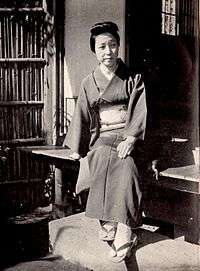Aya Kōda
Aya Kōda (幸田 文, Kōda Aya, September 1, 1904 – October 31, 1990) was a Japanese essayist and novelist.[1] She was the second daughter of Meiji period novelist Kōda Rohan. Her daughter Tama Aoki (b. 1929) and granddaughter Nao Aoki (b. 1963) are also writers.

Biography
Kōda was born in Tokyo. At the age of five, she lost her mother, and later her younger sister and brother. She studied at the Tokyo Women's School (Joshigakuin). She married at age 24, but divorced after 10 years and returned with her daughter, Tama, to live with her father. During World War II, she helped secure her father's job as described in Tama Aoki's Koishikawa no Ie (小石川の家, The house in Koishikawa). Her first works, written when she was 43, were memoirs of life with her father; they include Chichi (父, My Father) and Konna koto (こんなこと, Such an affair). Seen as the writings of a dutiful daughter, they achieved critical success.
Her subsequent short stories, novels, and essays explored women's lives, family, and traditional culture. They include the 1955 novel Nagareru (Flowing), which was made into a popular movie, as well as essays such as Kakera (Fragments) and Mono Iwanu Issho no Tomo (A Friend for Life), and short stories including Hina (Dolls for a Special Day) and Kunsho (The Medal). She received the Yomiuri Prize for Kuroi suso.[2]
Selected English translations
- The Writings of Kōda Aya, a Japanese Literary Daughter, Alan M. Tansman (trans.), Yale University Press, 1993.
- Mirror: The Fiction and Essays of Koda Aya, Ann Sherif (trans.), University of Hawaii Press, 1999. ISBN 0-8248-1899-7.
Selected works
- Kuroi Suso (黒い裾, Black skirt)
- Nagareru (流れる, Flowing)
- Tou (闘, Fight)
- Otōto (おとうと, My little brother)
- Misokkasu (みそつかす, Outsiders)
- Shuen (終焉, The Last Hours)
- Soso no ki (葬送の記, Funeral records)
References
- Sherif, Ann (1999). Mirror: The Fiction and Essays of Kōda Aya. University of Hawai'i Press. ISBN 9780824821814.
- "読売文学賞" [Yomiuri Prize for Literature] (in Japanese). Yomiuri Shimbun. Retrieved September 26, 2018.
- Japanese Wikipedia article
- German Wikipedia article
- "Aya Koda: Feminist and dutiful daughter", by Donald Richie, The Japan Times, Tuesday, Jan. 18, 2000.